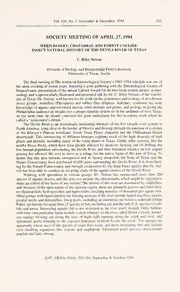
When Desert, Chaparral And Forest Collide - Insect Natural history Of The Devils River Of Texas PDF
Preview When Desert, Chaparral And Forest Collide - Insect Natural history Of The Devils River Of Texas
Vol. 105, No. 5, November&December, 1994 303 SOCIETY MEETING OF APRIL 27, 1994 WHENDESERT,CHAPARRALANDFORESTCOLLIDE: INSECTNATURALHISTORYOFTHEDEVILSRIVEROFTEXAS C.RileyNelson DivisionofBiologyand BrackenridgeField Laboratory UniversityofTexas, Austin ThefinalmeetingofTheAmericanEntomological Society's 1993-1994schedulewasoneof the moreexciting ofrecent years, featuring ajoint gathering with the Entomological Society of Pennsylvania,presentationoftheannual CalvertAwardforthebestlocalstudentprojectinento- mologyand aspectacularly illustrated andpresentedtalk by Dr. C. Riley Nelson, ofthe Univer- sityofTexas. Dr. Nelson,wellknownforhisworkonthesystematicsandecologyoftwodiverse insect groups, stoneflies (Plecoptera) and robber flies (Diptera: Asilidae), combined his wide knowledgeofaquaticandterrestrial insects, otheranimals and plants, andgeology ingiving the PhiladelphiaaudienceaninsightintoauniqueripariansystemsetinthearidlandsofwestTexas. At the same time, he clearly conveyed his great enthusiasm for this inventory work which he calleda"systematist'sdream." The Devils Riveris an exceedingly interesting tributary ofthe Rio Grande riversystem in NorthAmerica,lyingclosetotheborderofMexicoand flowingthroughthejunctionofecotones of the Edward's Plateau woodland, South Texas Plains chaparral and the Chihuahuan Desert desertscrub. This intersecting ofdifferent biotypes explains much ofthe high diversity ofboth plants and animals, including many ofthe rarest plants in Texas. Unlike other systems, like the nearby Pecos River, which have been greatly affected by intensive farming and oil drilling, the low human population surrounding the Devils Riverand theirhistorical reliance on low impact grazing has allowed this areato serve as arefuge forthe native faunaofthis part ofTexas. To insure that this area remains unimpacted and its beauty unspoiled, the State ofTexas and the NatureConservancy have purchased40,000acres surroundingthe Devils River. It is from fund- ingbythe NatureConservancy and throughcooperation by the State Parksagencythat Dr. Nel- sonhasbeenabletoconductanon-goingstudyoftheaquaticinsectsoftheDevils River. Working with specialists in various groups. Dr. Nelson has enumerated more than 200 speciesofaquaticinsects,andthisdoesnotincludethechironomids,whichmightbeexpectedto makeupathirdofthefaunaofanystream!Thespeciesofthisriveraredominatedbycaddisflies, and, becauseoftheopennatureoftheriparianregion,theseareprimarilygrazersandfilter-feed- ers(hydroptilids,hydropsychidsandleptocerids),reachingdensitiesofthousandspersquarefoot. Othergroupswellrepresentedintheflowingsectionsoftheriverincludebaetidmayflies,aquatic pyralidmothsanddobsonfiies. Deeppools, includinganenormousonebelowawaterfall (Dolan Falls),arehavensformorethan25speciesoffish,includinggarandtheonlyU.S.speciesofcich- lids and tetras. Interesting aquatic life is not restricted to the river itself, though. Other habitats withtheirownparticularfaunaincludeashorttributaryoftherivercalledDolan'sCreek,numer- ous springs flowing out along the base of high cliffs running along the creek and river, and ephemeral pools forming in the exposed limestone bedrock beside the creek. The springs are apparently wheremostofthespeciesofcrane fliesoccur,andtheseinterestingsitesalsoinclude cave dwelling organisms like isopods and amphipods. Ephemeral pools possess characteristic pupfishand fairyshrimp. ENT. NEWS 105(4): 303-304, September&October 1994
